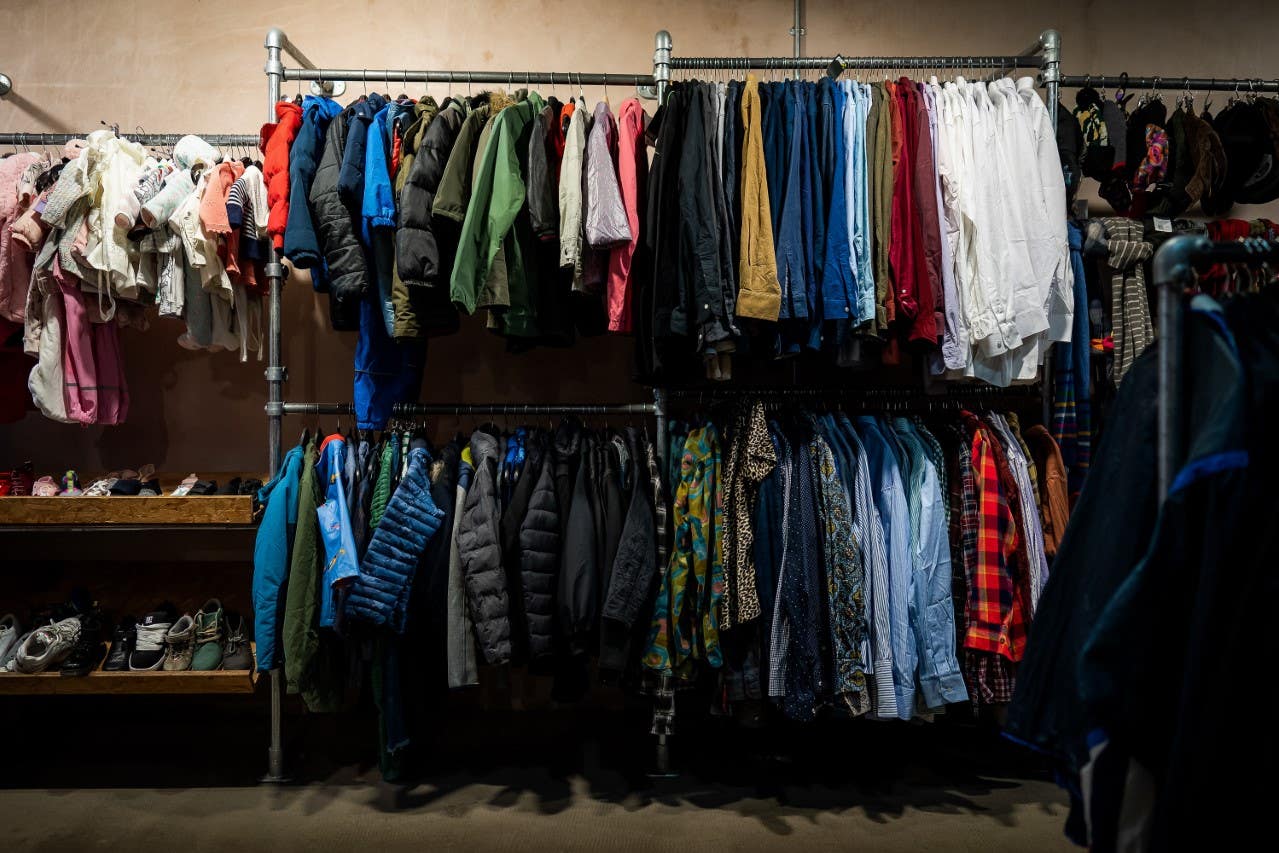How charity shop dump and running made us a nation of ‘reverse shoplifters’
When it comes to leaving unwanted clothes and books at charity shops, we all know the rules, who hasn’t been guilty of a fly-by drop at the local Oxfam store? Jonathan Margolis confesses to being part of a growing problem and asks: where CAN you get rid of stuff you don’t want to just chuck in the bin?


It’s a cold, wet December afternoon and I’ve spent the day filling three giant bags to take to a charity shop.
It’s the latest big push in a massive, year-long rationalisation of stuff – a result of the classic midlife scenario of two households merging. Last year my new partner and I moved into a small house together, each with decades of possessions. The quiet days between Christmas and the end of the new year feels like the perfect time to do a clear up and clear out.
The plethora of things we need to be rid of are pretty good quality, mostly duplicates. There’s a limit – basically, one - to the number of lemon juicers, fish kettles, CDs of Sgt. Pepper’s Lonely Hearts Club Band and unread copies of A Brief History of Time we’re going to need for our remaining years together.
We know the charity shop ground rules. Above all, their job is to rehome good stuff, not to sift through your rubbish for the occasional saleable item. So the main principle is “Donate don’t dump”. Charity shops don’t want anything broken or stained, and for safety reasons can rarely accept mains-powered electricals. Also, you shouldn’t give too much at any one time, especially books. They hate that, although not as much as they hate the ultimate no-no, leaving bags of unwanted things outside the shop door when it’s closed.
A lot of our surplus treasures, including some decent antique bits and pieces, might have sold for a small sum on eBay. But giving it to worthy charities gives me a pleasing case of the Christmas period warm fuzzies. Plus we really, really want to get rid of it all – we don’t want to be falling over the bags week after week.

Our hoard is all ready to go at 3.30pm, so I pick up a hire-by-the-minute Zipcar – living even in outer London there’s little point having your own car – and head towards the prosperous town nearby, which has a few rather select charity shops I browse round quite frequently. The plan is to distribute our largesse between them.
First mistake – the traffic is horrendous and the Zipcar has racked up £15 by the time I park. Second mistake; my favourite shop, right by where I’ve parked, is closed. This is irritating, but I pick up the bags – easily 50kg worth – and struggle a couple of hundred metres to the next one on the list. It also closed.
The last thing I want is to pay another £15 to take the same bags home again, but there’s another shop in the high street that I’m sure keeps normal shop hours. It’s not a charity I love, but at this point, I’d give them to a QAnon charity shop just to get rid of them. The shop of last resort is open and busy, but I see the bloke behind the counter looking a little unhappy at my enormous, bulging bags.
To avoid being told there’s too much, I swerve eye contact and leave (aka dump) the bags where I see a couple of small supermarket carriers have been put and make what can only be called a run for it.
It feels like I’ve been shoplifting in reverse – taking stuff into a shop and scarpering. There is an argument that what I’ve done, even with genuine goodwill, is a sort of emotional fly-tipping – a convenient way of dumping unwanted belongings while feeling you’ve done some good.
If I’m honest, this is not the first time that I have, if not strictly dumped stuff, then certainly left a charity shop urgently hoping not to hear the dreaded, “Sorry, we can’t take that.” And it transpires that reverse shoplifting is a serious concern in the charity shop sector. There has even been academic research into it. The International Journal of Integrated Waste Management, Science and Technology published a paper in 2018 based on work in Perth, Western Australia, on people who dump stuff, mostly by leaving it outside the door. The conclusion was that it was mostly transient people living in crowded urban areas who were guilty of making their rubbish problem someone else’s.
There as here, businesses, charities included, are required to pay to legally dispose of unrecyclable end-of-life goods in landfills. In the UK, the homelessness charity Emmaus reported in 2018, that one of its local groups spent £47,000 on getting rid of donations to its shops that were not fit for purpose. The British Heart Foundation said fees charged by local councils to dispose of unsaleable items cost the charity “up to hundreds of thousands of pounds a year”.
One charity shop manager tells me that reverse shoplifting is an issue for him, but says, charitably: “We get lots of amazing stuff, but we do also get people bringing in stuff that’s not fit for anything,” she said. “Dirty, stained clothes, broken toys, cracked dishes, quite revolting things. We once had a whole box of mouldy shoes. It’s quite amusing sometimes. They’ll say, ‘There’s some really nice stuff here,’ and when we go through it you think, ‘What nice stuff?’ But they’re mostly giving it with a good heart.”

Guilt and shame at throwing away serviceable consumer goods is a commendable spinoff of the environmental movement, but the sense of having done a good thing at the same time as getting rid of something arguably a bit nasty can be misplaced. The fashion industry consultants Textile Consult argue that charity shops are in danger of becoming part of the curse of cheap, fast fashion rather than the solution.
“The problem is that clothing donations are outweighing demand; literally turning charity shops into dumping grounds for unwise fast fashion choices,” they say. “It’s a vicious circle – the more clothes people buy, the more they constantly need to get rid of them too to make way for the latest haul.” Over 70 per cent of clothing donated to charity shops, the consultant claims, is ultimately sold to textile traders.
Books are a big problem for charity shops and, for people like me, who literally can’t give them away. Those that the charity shops can’t sell are consigned to a series of gradually more ignominious fates. They mostly get shipped out to traders who try to sell them through channels like Amazon and eBay. Those that remain unsold but are still in OK condition are shipped off to English-speaking developing countries, where there is demand for cheap reading and educational material. Books that are horrible, stained, scribbled on or falling to pieces end up being pulped and recycled.
In prosperous west London, one charity shop manager told me that the proportion of donations in general that can’t be sold is 30 per cent, and the other local shops reported 30 to 50 per cent rejections, but pointed out that unwanted things like old bedclothes or towels can be sold for rags, so the charity at least makes something.
Charity shops count themselves lucky if they have double red lines on the street outside, so cars can’t stop for even a minute to offload. “But some of our shops, where cars can stop, are like a dumping ground every night,” says one charity shop manager. “We have a problem with DVDs – who even uses them any more? – and for some reason jigsaws.”
“There’s a guilty look I recognise when some people come in through the door with a big bag. It doesn’t mean the stuff they are bringing is bad, but you can tell they’re desperate to get rid of it and go.”
The problem with getting rid of possessions you no longer want – but feel bad about taking to an actual dump – extends beyond slightly dodgy manoeuvres in charity shops.

When I was tripping over boxes of books recently, I saw at my local council dump some new collection bins from an American social enterprise called Better World Books. I put several hundred books in there in the hope they would go to a better place, but somehow it didn’t seem hopeful. The once-treasured volumes looked rather pathetic in a bin at a rubbish dump.
A year later, the Better World Books bins had been replaced by a Traid clothes bank. I asked Better World Books what had happened. Had they been dismayed, as I imagine, by having dumped on them books good only for being pulped?
They declined to answer.
How to get rid of your...
Electricals: the website Recycle Your Electricals will help find somewhere to get unwanted or broken gadgetry repaired or constructively dismantled for parts.
Clothing: items can be left in bins from charities like Traid, but they are sometimes raided by criminals – there is a whole category of theft from such clothing banks known as “waste crime”. Thieves sell the good stuff on eBay. If you want to be sure your unwanted clothing doesn’t end up making money for a criminal gang, it’s best – although tedious – to donate small bags of the good stuff to a shop or sell it on eBay/Vinted yourself.
Books: Try Ziffit, a wonderful app that buys good books and even picks them up from you – a huge labour-saving benefit. Ziffit scans a book’s barcode and makes an offer paying anything from a few pence to a couple of pounds.






Join our commenting forum
Join thought-provoking conversations, follow other Independent readers and see their replies
Comments